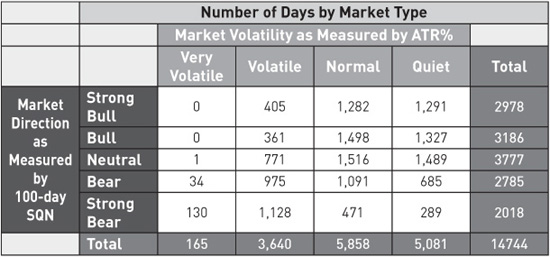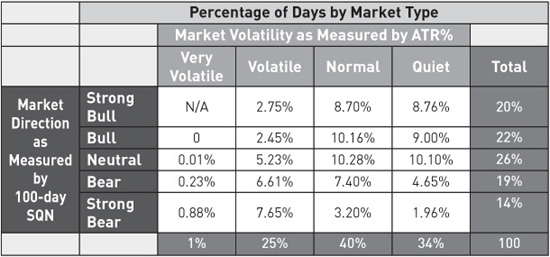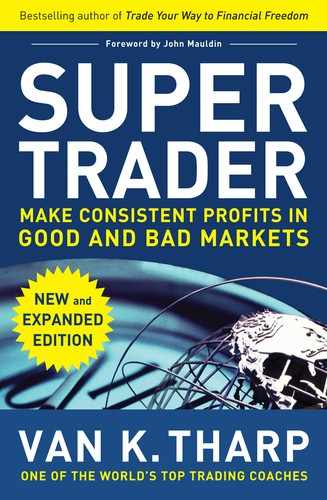INTRODUCTION
The Five Steps to Consistent Profits
The goal of this book is to help people develop a full-time trading business that produces consistent, above-average profits under various market conditions. This means that you can perform profitably in up markets (both quiet and volatile), down markets (both quiet and volatile), and sideways markets (both quiet and volatile). If you are reading this, you probably would like that sort of performance. To help traders reach this goal, I’ve designed a five-step approach. My objective here is to familiarize you with the five steps you must take:
1. Work on yourself and your personal issues so that they won’t get in the way of your trading. This step must be accomplished first; otherwise, those issues will interfere with each of the other steps.
2. Develop a business plan as a working document to guide your trading. This plan is not to raise money, which is the purpose of many business plans. Instead, it’s designed to be a continual work in progress to guide you throughout your trading career. The business plan actually helps you with all four of the other steps. It also includes an overview of the big picture influencing the markets you will be trading and a method for keeping on top of those factors so that you will know when you are wrong. In the first issue each month of my free e-mail newsletter, Tharp’s Thoughts, I update my big picture view and include the updated market type analysis for the S&P 500.
3. Develop several trading strategies that fit your view of the big picture, and understand how each of them will perform in various market types. The ultimate goal of this step is to develop something that will work well in every possible market condition. It’s not that hard to develop a good strategy for any particular market condition (including quiet and sideways). What’s difficult (and maybe impossible) is to develop one strategy that works well in all market conditions, which is what most people attempt to do.
4. Thoroughly understand your objectives and develop a position sizing strategy to meet them. Probably fewer than 10% of all traders and investors understand how important position sizing is to trading performance, and even fewer understand that it is through your position sizing methods that you meet your objectives. Thus, the fourth step is to develop position sizing strategies for each system that will help you meet your objectives.
5. Monitor yourself constantly and minimize the number of mistakes you make. I define a mistake as not following your rules. Thus, for many people who have no written rules, everything they do is a mistake. However, if you have followed the first four steps, you will have rules to guide your trading, and you will be able to define a mistake as not following those rules. Repeating the same mistake is self-sabotage. By monitoring your mistakes and continuing to work on yourself, you can minimize their impact. People who do this, in my opinion, tend to produce consistent, above-average profits.
Part 1. Working on Yourself
Everything you do is shaped by your beliefs—in fact, your reality basically is shaped by your beliefs. What’s a belief? Every sentence I’ve written (including this one) reflects my beliefs. Every sentence that comes out of your mouth reflects your beliefs, and your beliefs shape your reality. Even who you think you are is shaped by your beliefs.
Let me give you an illustration of how this works. My niece from Malaysia came to live with us when she was 19 years old (my wife and I were putting her through college in the United States). After she’d been with us for a year, one day she said to me, “Uncle, in my next lifetime, I would like to be born beautiful and talented.” My niece is very artistic (she sailed through an art course) and sings like she was born to sing. Coming from a liberal arts background, she got a degree in biomedical engineering, graduating cum laude. I think she passes the talent criterion with flying colors. As far as beauty, I’d describe her as one of the most stunningly beautiful women I’ve ever seen, and everyone who meets her comments on how beautiful she is. Thus, here was an incredibly beautiful and talented woman who, because of her beliefs, didn’t think she had those qualities at all. Your reality is shaped by your beliefs. By the way, I’ve been working on those beliefs of hers since she’s been living here, and she’s finally coming around.

My Niece
Similarly, how you trade is shaped by your beliefs. You do not trade the markets. Instead, you trade your beliefs about the market. One of the key aspects of working on yourself is to examine your beliefs to determine whether they are useful. If they are not useful, find beliefs that are. This is a key aspect to working on yourself.
You probably will never be free of limiting beliefs or all aspects of self-sabotage during your lifetime, but I consider this step complete when you transform five very limiting aspects of your life and feel very differently about each one. Once you’ve accomplished five such transformations, I consider you capable of generally overcoming the future roadblocks that may come up in your trading.
Part 2. Developing a Working Business Plan
The business plan part of trading includes step 1. In fact, a good trading business plan includes a thorough examination of the person who is doing the trading: beliefs, issues, strengths, challenges, and goals. Everything you can think of about yourself should be included in this document.
However, the plan also should include many other important things:
• Your assessment of the big picture and how you’ll keep up with it. For example, I wrote about the possibility of a huge secular bear market in 2001 when I first started working on my book Safe Strategies for Financial Freedom.1 I decided that the big picture should include (1) a general assessment of the stock market in the United States and worldwide, (2) a general assessment of the strongest and weakest areas of the world for investments, (3) a general assessment of the strength of the dollar (or your home currency if you are not using the U.S. dollar), and (4) a general assessment of inflation or deflation potential in the future. I also developed ways to measure each of these elements, and my way of keeping up with them is to write a market update each month in my newsletter.
• Business systems. These include how you will do research, monitor your data, market yourself (to your family or clients), monitor yourself, manage your cash flow, and keep track of your trades and performance. Running a trading business involves many systems other than trading systems. To have a successful trading business, you’ll have to master those other systems.
• Several trading strategies that fit the big picture and that work when conditions change. For example, strategies that work in volatile bear markets (for example, 2008) are quite different from strategies that work in quiet bull markets (for example, 2003).
• A worst-case contingency plan. You’ll need to be prepared for anything major that could upset your trading business. This sort of planning often takes as long as six months to complete.
Part 3. Developing a Trading System
In 1999, everyone in America seemed to be a stock market expert. When we were giving a stock market workshop at a hotel in Cary, North Carolina, we overheard one of the bartenders say, “Perhaps we should take Dr. Tharp’s workshop.” The second bartender responded, “No, I don’t need that. I could teach a workshop like that.” Similarly, a waiter in a high-class steak restaurant informed us that he was really a trader but worked at a restaurant part time at night. He’d already made over $400,000 trading and considered himself an expert trader. My guess is that these people didn’t survive the period 2000 to 2002, much less the market in 2008. Why? They were different markets, and a strategy of buying and holding high-tech stocks that worked in 1999 has had mixed to horrible results in the years since then.
However, a strategy of buying inverse index funds as soon as the market signaled a clear bear market in 2007 worked wonders in 2008. You need to know what kind of market we are in. I believe that there are as many as 20 different market types based on direction and volatility. For direction, there are five types of moves: very bullish, bullish, sideways, bearish, and very bearish. As for volatility, I see four conditions: supervolatile, volatile, normal, and quiet. For any given period, the market is a combination of those two criteria. Here are a few examples: very bullish normal, sideways volatile or bearish supervolatile. (Note: I have yet to find any bullish supervolatile periods.)
Your definition of market type might be different depending on your investment or trading perspective. However, I look at 13-week rolling windows. I calculate the System Quality Number® (SQN®), a proprietary indicator, for the market’s daily percent change over the last 100 days. Superbullish is a score of 1.5 or greater, bullish is between 0.75 and 1.5, neutral is between 0.75 and 0, bearish is between 0 and −0.45, and superbearish is when the indicator is below −0.45.
I also measure volatility using the market’s (again, the S&P 500’s) average true range (20-day ATR) as a percentage of today’s close. I call this the ATR%, and I use it to determine the mean and standard deviation for all 20-day windows. When the ATR% is more than 3.0 standard deviations above the historic mean, the market is considered to be supervolatile—and that occurs only during bear markets. When the ATR% is between 3.0 and 0.5 standard deviations above the mean, it is volatile; when the ATR% is between 0.5 and −0.5 from the mean, it is normal; and when it is below 0.5 standard deviations from the mean, it is quiet. As a rule, bull markets tend to be volatile to quiet, while bear markets tend to be normal to very volatile. Table I-1 summarizes 58 years’ worth of data according to market type for the S&P 500.
Notice that very volatile conditions have not occurred in strong bull or bull markets. Similarly, quiet conditions are very rare in strong bear markets.
Typically, most people attempt to develop one strategy that works in all types of markets. The waiters, bartenders, and most others for that matter, usually fail for this reason. However, there is good news: it’s not that hard to develop multiple strategies so you can have one that will work well in each kind of market. What’s difficult is to try to find one that will work well in all conditions. However, you don’t have to do that if you simply monitor market conditions and are ready with multiple systems.



TABLE I-1 Fifty-Eight Years’ Worth of Data According to Market Type for the S&P 500
Part 4. Understanding the Importance of Position Sizing Strategies
In our workshops we typically play a marble game. Marbles are placed in a bag to represent a trading system. For example, 20% of the trades in a system may result in 10R winners. Since R is short for what you risk, a 10R winner is one for which you make 10 times what you risk. The system also may include 70% 1R losers, meaning that when one of those marbles is drawn, you lose whatever you risk. Finally, the system may include 10% 5R losers, meaning that when those marbles are drawn, you lose 5 times what you risk. The marbles are replaced after they are drawn so that your odds remain the same after each draw.
Now, some of you might be thinking, “But you’ll lose 80% of the time. How can you possibly make money?” Let’s say there are 100 marbles in the bag. If you total the R values of all the marbles in the bag, you’ll find that they add up to +80R. That means that on the average you’ll make 0.8R per pull over many, many marble draws. Thus, the expectancy of the system, the average R value, is 0.8R (after 100 trades, you’ll probably be up about 80R). If you risked about 1% on each marble pull, after 100 pulls you’d probably be up more than 80%. Perhaps now the system doesn’t seem so bad.
When I play the game, I usually provide the audience with different incentives. For example, I might say that if you go bankrupt, you are out of the game and have to pay a fine of $10. I also might say that if you end the game down 50%, you have to pay a fine of $5. I could also say that if you lose money by the end of the game, it will cost you $2.
On the positive side, I might say that if you make money, you’ll win $2. If you make 50%, you’ll win $5. I also might say that if you make the most money, you’ll win whatever is left in the pot, say, $100.
Note how my incentives set up a number of objectives for the game. For example, here are three possible objectives:
1. To win the game at all costs—even if that means bankruptcy along the way. The person who wins the game usually has this objective.
2. To win at least $2 and make sure you don’t lose more than $2. Note that this is an entirely different objective.
3. To win the game but make sure you don’t go bankrupt. Again, this is an entirely different objective from the first two.
When I tell people how to strategize about the game, I suggest that they answer the following questions:
• Who are you?
• What are your objectives?
• What is your position sizing strategy (that is, how much you will risk) to reach your objectives?
• Under what conditions might you be willing to change your position sizing strategy?
If 100 people play the game (starting with $100,000) and all get the same trades (that is, the same marble pulls randomly made and replaced), chances are that there will be 100 different equity amounts at the end of the game. Also, you will be able to group people according to their objectives. For example, those who try to make money and have minimal losses will have a small fluctuation of equity of about 5% to 10%. However, those trying to win the game will have huge equity fluctuations that range from bankruptcy to making millions.
The game dramatically illustrates what is really important to trading success: the how-much variable of your position sizing method. Thus, a key step for anyone wanting consistent profits is to develop a trading system with a positive expectancy and then develop a position sizing strategy that maximizes the probability of meeting one’s objectives. This hugely important step is largely ignored by most traders and investors, including most professionals.
Part 5. Reducing Mistakes and Other Ways to Make More Consistent Profits
What happens when you don’t follow your rules? You make a trade when your system didn’t tell you to trade. You are supposed to get out when your stop is hit, but you don’t get out. Your position size is way too big on one particular trade. Those are all mistakes, and mistakes can be very costly.
We’ve done some preliminary research on the cost of mistakes, and the results suggest that for futures traders, mistakes can run as high as 4R per mistake. If a person makes just 10 mistakes in a year, that person could find his or her profits dropping by about 40R. That means that if he or she made 50% on the year, that investor could have made nearly 100%. If he or she lost 20%, then mistake-free trading could have made that person profitable.
For swing traders who are trading equities, the mistakes seem to be worth about 1R. Thus, if you made 10 trades a week with an expectancy of 0.4R, you’d make 4R. But if you made one mistake each week, you’d lose about 25% of your profit.
For long-term investors with wide stops, mistakes probably cost about 0.4R per mistake. The total cost per year with 10 mistakes is about 4R. However, the average investor is lucky to make 20% per year, and so 10 mistakes could easily cost an investor 20% of his or her profits.
The final step that you must concentrate on is to minimize the impact of mistakes on your trading. This amounts to developing a disciplined routine in your trading and continuing to take step 1: working on yourself.
